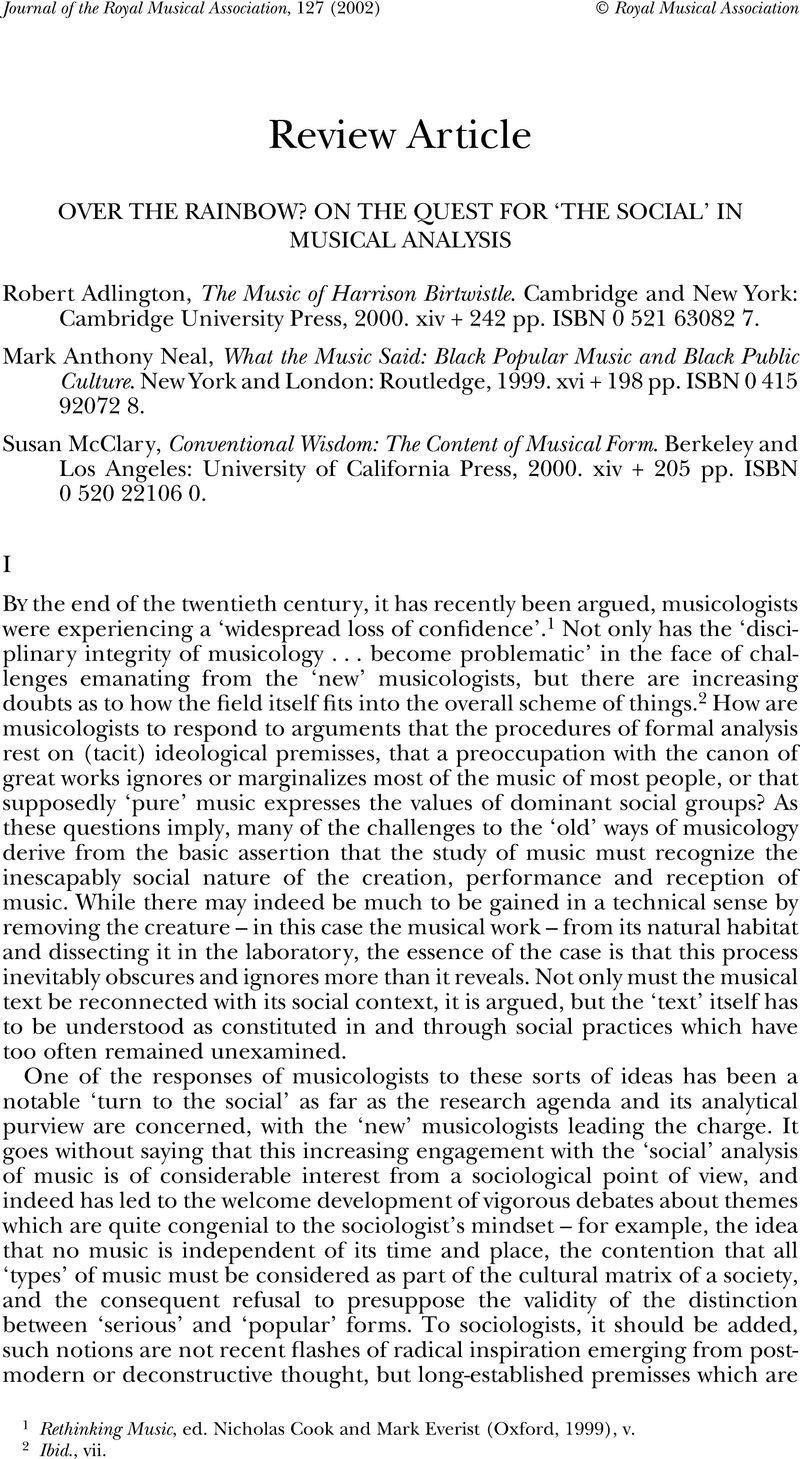No CrossRef data available.
Article contents
Over the Rainbow? On the quest for ‘the social ’ in musical analysis
Review products
Published online by Cambridge University Press: 01 January 2020
Abstract

- Type
- Review Article
- Information
- Copyright
- Copyright © Royal Musical Association, 2002
Footnotes
References
1 Rethinking Music, ed. Nicholas Cook and Mark Everist (Oxford, 1999), v.Google Scholar
2 Ibid., vii.Google Scholar
3 Martin, Peter J., ‘Music and the Sociological Gaze’, Svensk tidskrift for musikforskning, 82 (2000), 41–56.Google Scholar
4 Martin Jay, The Dialectical Imagination: A History of the Frankfurt School and the Institute of Social Research, 1923–1950 (London, 1973; repr. Berkeley and Los Angeles, 1996), 222; Rolf Wiggershaus, Die Frankfurter Schule: Geschichte, theoretische Entwicklung, politische Bedeutung (Munich, 1986), trans. Michael Robertson as The Frankfurt School: Its History, Theories and Political Significance (Cambridge, 1994), 236–46.Google Scholar
5 C. Wright Mills, The Sociological Imagination (New York, 1959), 50ff.Google Scholar
6 Jean-François Lyotard, La condition postmoderne: Rapport sur le savoir (Paris, 1979), trans. Geoff Bennington and Brian Massumi as The Postmodern Condition: A Report on Knowledge (Manchester, 1984).CrossRefGoogle Scholar
7 Adorno, Theodor W., ‘Zur gesellschaftlichen Lage der Musik’, Zeitschrift für Sozialforschung, 1 (1932), 103–24, 356–78; trans. as ‘On the Social Situation of Music’, Telos, 35 (1978), 128–64 (p. 151). This is the first publication that links Adorno to the Frankfurt Institute for Social Research; Max Horkheimer, the Institute's director, was founding editor of the Zeitschrift für Sozialforschung (see Wiggershaus, Die Frankfurter Schule, 116–22).Google Scholar
8 Russell A. Berman and Robert D'Amico, ‘Popular Music from Adorno to Zappa’, Telos, 87 (1991), 71–7 (p. 71).Google Scholar
9 Adorno, Theodor W., Philosophie der neuen Musik (Tübingen, 1949; repr. Frankfurt am Main, 1958), 38.Google Scholar
10 Max Paddison, Adorno's Aesthetics of Music (Cambridge, 1993), 262.Google Scholar
11 Lambert Zuidervaart, Adorno's Aesthetic Theory: The Redemption of Illusion (Cambridge, MA, and London, 1991), 119.Google Scholar
12 Becker, Howard S., ‘Ethnomusicology and Sociology: A Letter to Charles Seeger’, Ethnomusicology, 33 (1989), 275–85 (pp. 281–2).CrossRefGoogle Scholar
13 Antoine Hennion, ‘The Production of Success: An Anti-Musicology of the Pop Song’, On Record: Rock, Pop and the Written Word, ed. Simon Frith and Andrew Goodwin (London, 1990), 185–206, and idem, ‘Baroque and Rock: Music, Mediators, and Musical Taste’, Poetics, 24 (1997), 415–35.Google Scholar
14 Paddison, Adorno's Aesthetics, 184.Google Scholar
15 Tia DeNora, ‘How is Extra-Musical Meaning Possible? Music as a Place and Space for “Work”‘, Sociological Theory, 4 (1986), 84–94.Google Scholar
16 Martin, Peter J., Sounds and Society: Themes in the Sociology of Music (Manchester, 1995), 118–19.Google Scholar
17 Nicholas Cook, Music: A Very Short Introduction (Oxford and New York, 1998), 78.Google Scholar
18 Becker, Howard S., Art Worlds (Berkeley, 1982).Google Scholar
19 Brian Ward, Just my Soul Responding: Rhythm and Blues, Black Consciousness and Race Relations (London, 1998).Google Scholar
20 See, for example, Martha Bayles, Hole in our Soul: The Loss of Beauty and Meaning in American Popular Music (Chicago, 1994); Donald Clarke, The Rise and Fall of Popular Music (London, 1995); William G. Hyland, The Song is Ended: Songwriters and American Music, 1900–1950 (New York, 1995).Google Scholar
21 Nicholas Lemann, The Promised Land: The Great Black Migration and How it Changed America (London, 1991).Google Scholar
22 Susan McClary, Feminine Endings: Music, Gender, and Sexuality (Minneapolis, 1991).Google Scholar
23 See, for example, John A. Hughes, Peter J. Martin and W. W. Sharrock, Understanding Classical Sociology: Marx, Weber, Durkheim (London, 1995), 135ff.Google Scholar
24 Becker, ‘Ethnomusicology and Sociology’.Google Scholar
25 Jacques Attali, Noise (Manchester, 1985).Google Scholar
26 Martin, Sounds and Society, 114–16; see also Zuidervaart, Adorno's Aesthetic Theory, 97–9.Google Scholar
27 Rose Rosengard Subotnik, Developing Variations: Style and Ideology in Western Music (Minneapolis, 1991), 271.Google Scholar
28 Becker, Art Worlds, 282.Google Scholar
29 Tia DeNora, Music in Everyday Life (Cambridge, 2000).Google Scholar
30 See above, note 18; see also Howard S. Becker, ‘Art as Collective Action’, American Sociological Review, 39 (1974), 767-76.Google Scholar




